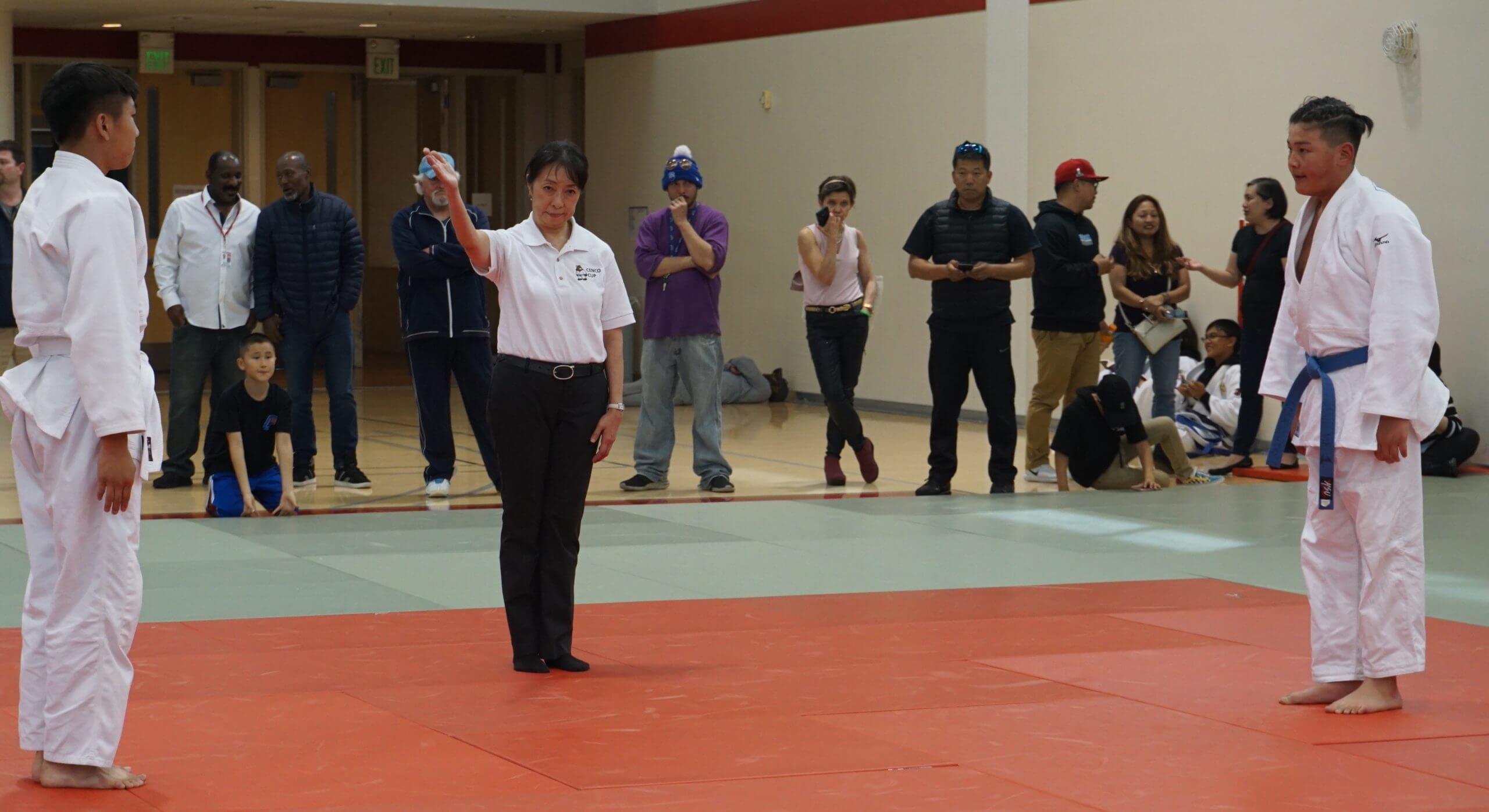
Contest Rules and Referee Education:
Local/Regional Certification
5 Modules
Module 1: Overview
Module 1 provides a general introduction to the contest rules including; judo contest basics, bowing procedures, gripping, throw scoring, mat work scoring, common referee hand signals and calls, penalty overview and how to read the scoreboard. It is a great base knowledge module for all interested in knowing more about Judo contest rules. The module incorporates three sections: Procedures, Scoring and Penalties.
At the conclusion of Module 1;
- You will be able to assemble elements of a judo contest, contest bowing, kumi kata (gripping), judo -gi, referee hand signals and calls and scoreboard basics.
- You will be able to differentiate Tachiwaza Scoring – Ippon and Wazari, Ne-waza Scoring – Osaekomi, Shime-waza and Kansetsu-waza.
- You will examine and distinguish the difference between Shido (Slight Penalty) and Hansoku Make (Grave Penalty).
Module 1: Procedures
- Introduction to a Judo Contest
- Contest Bowing Procedures
- Kumi Kata (Gripping)
- Judo Gi
- Referee Hand Signals and Calls
- Scoreboard Basics
Module 1: Scoring
- Tachiwaza Scoring
- Ippon
- Wazari
- Ne-waza Scoring
- Osaekomi
- Shime-waza
- Kansetsu-waza
Module 1: Penalties
- Shido (Slight Penalty)
- Hansoku Make (Grave Penalty) Overview
Module 2: Overview
Module 2 provides more contest rule information, including; Referee’s focus, positioning and attire, examples of Ippon, Wazari and Osaekomi and common penalties and their gestures. The module incorporates three sections: Procedures, Scoring and Penalties.
At the conclusion of Module 2, you will be able to;
- Describe the referee’s focus, positioning and attire
- Differentiate Scoring – Ippon, Wazari and Osaekomi
- Distinguish common penalties and their gestures.
Module 2: Procedures
- Referee Focus
- Safety of the Players
- Fairness and Consistency
- Referee Positioning
- Attire
Module 2: Scoring
- Nage waza Scoring
- Ippon – Clear examples
- Wazari – Clear examples
- Ne waza Scoring
- Osaekomi – Clear examples
- Tachi waza / Ne waza Transition
Module 2: Penalties
- Shido (Slight Penalty)
- Shido for a Lack of Combativity
- Shido for an Illegal Move
- Hansoku-make (Grave Penalty)
- Hansoku-make for Acts against the Spirit of Judo (cannot continue)
Module 3: Overview
Module 3 provides more examples of Ippon, Wazari, non-scoring throws, landings and less common penalties and their gestures.
At the conclusion of Module 3, you will be able to;
- Differentiate marginal landing examples of Scoring – Ippon and Wazari
- Distinguish score and no score landings
- Examine and distinguish penalty for lack of combativity
- Distinguish illegal moves in kumi-kata
Module 3: Scoring
Nage waza Scoring
- Ippon or Wazari -Marginal landing examples
- Score or No Score – Continuation examples
Module 3: Penalties
- Shido (Slight Penalty)
- Shido for an Illegal Move
Module 4: Overview
Module 4 provides additional examples of Ippon, Wazari, non-scoring landings and less common penalities and their gestures, including direct Hansoku Make.
At the conclusion of Module 4, you will be able to;
- Differentiate marginal landing examples of Scoring – Wazari or no score 90 degree landings and no score shoulder/upper back
- Examine and distinguish penalty for lack of combativity, illegal move and untidy attire or hair
- Distinguish Hansoku-make for dangerous techniques.
Module 4: Scoring
- Nage waza Scoring
- Score or No Score-marginal landing examples
- Wazari or No Score 90 degree– marginal landing examples
- Wazari or No Score Shoulder/ Upper Back- marginal landing examples
Module 4: Penalties
- Shido (Slight Penalty)
- Shido for a Lack of Combativity
- Shido for an Illegal Move
- Shido for Untidy Attire or Hair
- Hansoku Make (Grave Penalty)
- Hansoku-make for Dangerous Techniques (can continue)
Module 5: Overview
Module 5 provides additional examples of Ippon, Wazari, non-scoring landings and less common penalities and their gestures, including direct Hansoku Make.
At the conclusion of Module 5, you will be able to;
- Differentiate opponents counter attack and push down examples
- Examine and distinguish grip below belt at end phase of throws and Kaeshi waza
- Analyze and assess Shido for an Illegal move
- Examine and assess Hansoku-make for dangerous techniques.
Module 5B: Scoring
Nage waza Scoring
-
- Counter roll to back examples
- Grip below belt at end phase of throw examples
- Kaeshi waza examples
Module 5C: Penalties
Shido (Slight Penalty) Shido for an Illegal Move
-
- Hooking one leg between the opponent’s legs
- Take the judogi in the mouth
- Put a foot or a leg in the opponent’s belt, collar or lapel.
- To kick with the knee or foot, the hand or arm of the opponent
- Both of the contestants are in a tachi-shisei (standing position) and one or both apply kansetsu-waza or shime-waza
- No score and shido for reverse seoi-nage
Hansoku Make (Grave Penalty)
-
- Hansoku-make for Acts against the Spirit of Judo (cannot continue)
- To apply kawazu-gake
- To apply kansetsu-waza anywhere other than to the elbow joint
- To fall directly to the tatami while applying or attempting to apply techniques such as Ude-Hishigi-Waki-Gatame
- To reap the opponents supporting leg from the inside
- To make any action this may endanger or injure the opponent
- To intentionally fall backwards when the other contestant is clinging to his back
- To lift the opponent off the tatami and forcefully push him back onto the tatami without a judo technique.
- To disregard the referee’s instructions
- To wear a hard or metallic object

